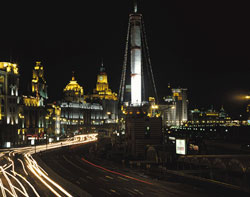|
||||||
|
Beijing | Tianjin |Shanghai | Chongqing | Tibet | Hebei |Chanxi |Inner Mongolia | Liaoning | Jilin | Hunan
|
|||||
|
Ancient Cultural Street
The 580-metre-long Ancient Cultural Street is a major tourist destination where Tianjin's old traditions remain largely intact. Imitation Qing buildings, which house nearly 100 shops are scattered along the street with the Tianhou Temple in the center. Built in 1320 during the Yuan, the Tianhou (Heavenly Queen) Temple, also known as Temple of the Patron Goddess, is one of many temples established in China's coastal areas in honour of the mythological angel known more popularly as Mazu. Grand sacrificial ceremonies were held in the temple on Mazu's birthday, which fell on the 23rd day of the 3rd lunar month. Today the temple has been converted into the Tianjin Folklore Museum. |
|
||||
|
Guangdong Cuild Hall
The Guangdong Gild Hall in Nanmennei Street was built by Guangdong natives in 1907 so that they could have a place to get together. It is a unique structure built in the style of an ancient-looking quadrangle. Today it is the Tianjin theatre Museum.
Martial Artist's Tomb
Huo Yuanjia, a celebrated master of traditional Chinese martial arts is a household name in China for his superb mastery of martial arts and patriotic, chivalrous deeds. His former residence and tomb, now open to the public, are in Xiqing District of Tianjin.
Zhou & Deng Memorial
The memorial hall dedicated to Zhou Enlai and Deng Yingchao is a 6-hectare affair to the north of the Park-on-the-Lake. Its buildings, with a total floor space of 7, 150 square metres, include a prelude hall, exhibition of the couple's lives, movie house, assembly hall, reception room, research center, warehouse, and a plane that Zhou used during his lifetime.
Tianjin Beach Resort
The beach resort by the Bohai Sea lies 4.5km to the southeast of Tianjin. With convenient transportation, a serene and secluded environment, an bathing ground, and a good assortment of water sports and recreational facilities, the beach is an ideal destination for sightseeing, holiday making, and recuperating purposes. Accommodations run the gamut from star=rated hotels to guestrooms-on-the-sea, compact villas, and tents pitched right on the beach. Seafood is available in local restaurants.
Haihe River Cruise
The Haihe River meanders its way through the city of Tianjin. The renowned cruise on the river features the Haihe Park, the Fountain Amusement Park, magnificent waterfront homes, and green parklands, and gives a comprehensive view of what the landscape of Tianjin is all about.
Park-on-the-Lake
Isles jutting out of a vast expanse of water are a salient feature of the famed Park-on-the-Lake in Nankai District. The park is close to the Tianjin Zoo, home to giant pandas, golden-haired monkeys and other endangered species.
Dule Temple
Situated at the Western Gate of Jixian County, the Dule (Solitary Happiness) Temple is a typical ancient wood structure dating back to the Tang. A frontal archway and the Guanyin Pavilion, both of which are a legacy of the Liao, are what have remained of this temple. The Guanyin Pavilion is the shrine of a fine example of Liao sculpture-a 16-metre clay statue of the Goddess of Mercy, known as "Guanyin with Eleven Heads" because the unknown sculptor has erected 10 miniature replicas of the head of the goddess on her temple.
Great Wall at Huangya Pass
This refers to a famous section of the Great Wall built in 556 AD north of Jixian County. Here the Great Wall looks at once majestic, awesome, exotic and elegant as it stretches heroically for 3,025 metres along mountain ridges and across rivers.
Panshan Scenic Resort
The Panshan Mountain, found north west of the seat of Jixian County, is extolled as "No.1 Mountain East of the Chinese Capital". The beauty about this scenic resort lies in the pine trees that from an overhead canopy over the mountaintop, the statuesque rock formations midway on its slope, and the streams and rivulets that skirt the foothills. The Shiqu (Interesting Stone) Garden, a new tourist attraction south of the main peak, is known for a vast assemblage of rocks in life-like shapes and images.
Educational Tour
Tainjin is a major center for tourists who come to China for educational purposes. Many schools in the city have fostered enduring exchange relations with Japan and some other countries. Visitors taking part in this tour program are organized to visit families and schools for people-to-people exchanges, go sightseeing in the around the city, and experience the delights of "being a Tianjin citizen for a single day".
Great Wall International Marathon
The Huangyaguan section of the Great Wall in Jixian County, is the venue of an international marathon that runs across rivers and farm fields along a 42.5km route which the International Track and Field Association has designated as a standard international cross-the-country marathon route. This event, which takes place in May every year, has drawn warm response from the world market for its combination of a Western sporting program with the ancient Great Wall as a symbol of Oriental culture. Every year the event is joined by more than 1,000 athletes, many of them from the United States, Britain, Denmark, Norway, Germany and Ice land and the Hong Kong Special Administrative Region.
The Bund
Huangpu River
Cruise
Yangpu & Nanpu
Bridges
Longhua Temple
Tour of Residential
Quarters
"Pedestrians Only"
Nanjing Road
The Oriental pearl
TV Tower
Grand View Garden
Shanghai Museum
Arts & Crafts
Research Institute
Shanghai
tourist Festival |
|||||




